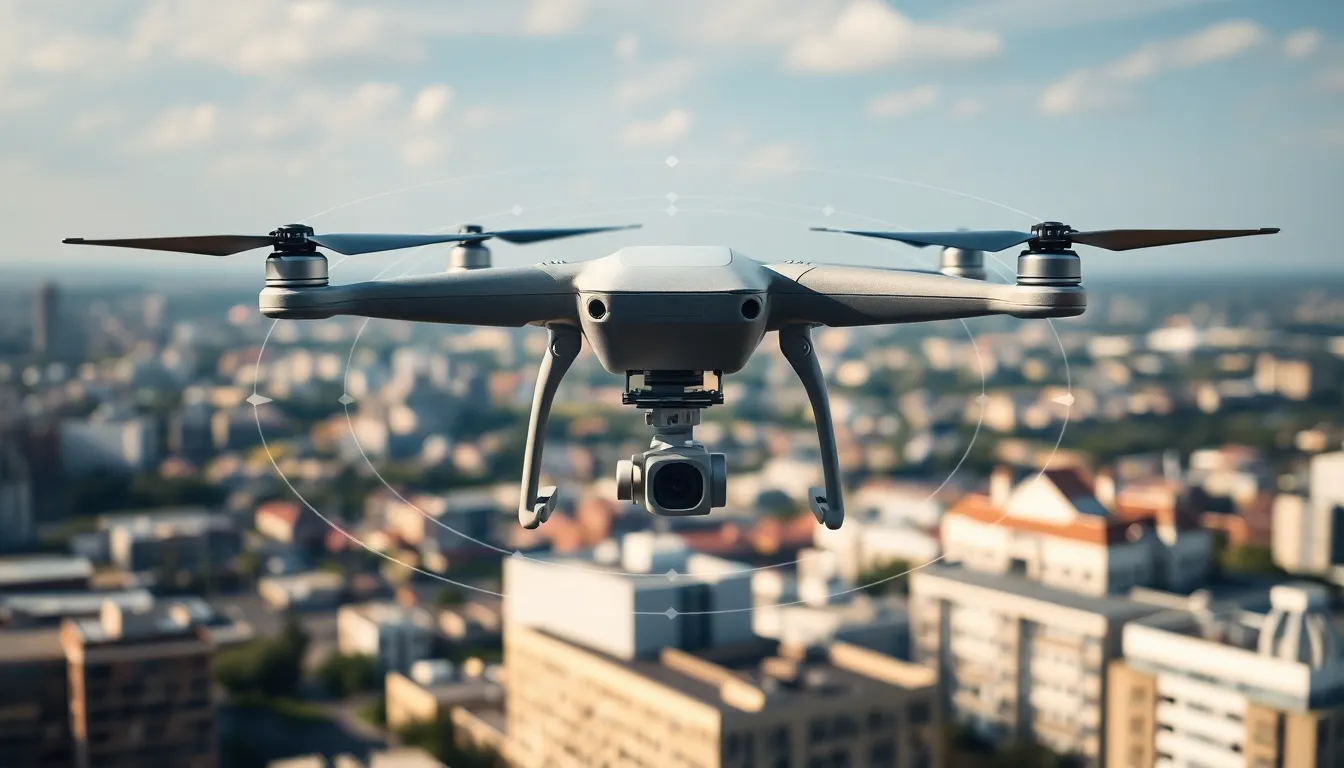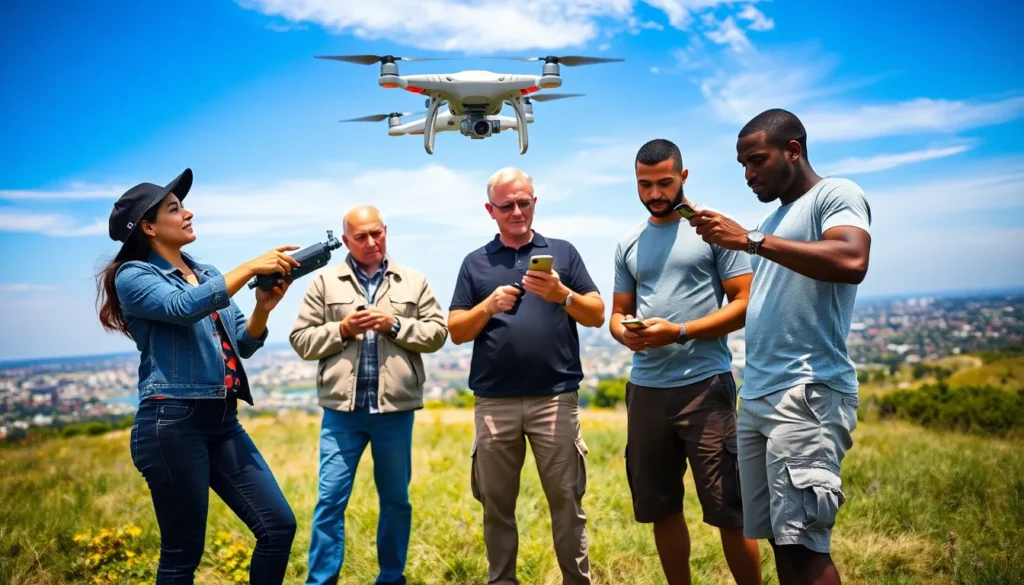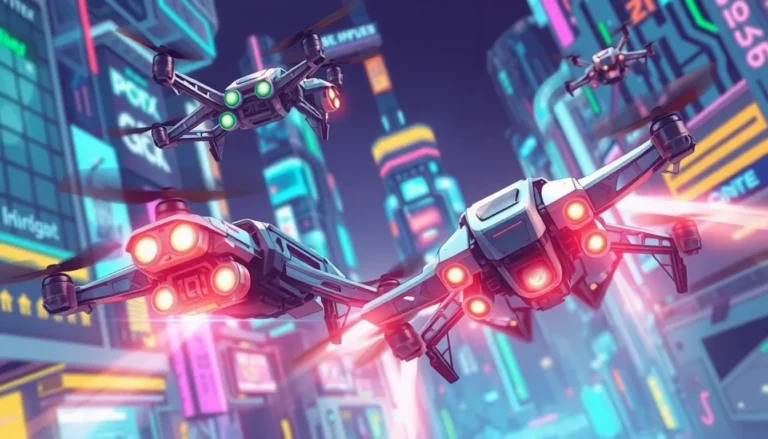Table of Contents
ToggleIn a world where drones are becoming the new superheroes of the skies, it’s crucial to keep them on the right side of the law. Enter drone geo-fencing, the digital bouncer that ensures these flying machines don’t crash the wrong parties. Imagine a drone that knows when to party and when to stay home—thanks to geo-fencing, it won’t be making any uninvited appearances in no-fly zones.
Overview of Drone Geo-Fencing
Drone geo-fencing plays a crucial role in regulating flight paths and enhancing safety. This technology uses GPS or RFID to create virtual boundaries, restricting drones from entering designated areas. These no-fly zones include airports, military bases, and densely populated regions. By setting up geo-fencing, operators maintain compliance with aviation regulations.
Geo-fencing enhances operational security for both commercial and recreational drone users. It helps prevent unauthorized access to sensitive locations, reducing the risk of accidents or conflicts. In addition, aviation authorities and local governments utilize geo-fencing data to monitor drone activity and enforce regulations.
Variables affecting drone geo-fencing effectiveness include GPS accuracy and data updates. It’s vital for operators to use up-to-date information, ensuring that boundaries reflect current regulations. Geo-fencing software regularly incorporates these updates, providing reliable data for users.
Geo-fencing improves overall safety and efficiency by enabling better flight planning. Pilots often receive alerts when approaching restricted airspace, allowing for timely adjustments. Implementing this technology significantly reduces the chances of unintentional non-compliance.
Different drone models come equipped with various geo-fencing capabilities, tailored to meet specific user requirements. Manufacturers design systems with customizable features, enabling operators to adjust boundaries and settings as needed. Operators must thoroughly understand their drone’s geo-fencing functions to maximize advantages.
Importance of Drone Geo-Fencing

Drone geo-fencing serves as a critical technology for ensuring flight safety and compliance with regulations.
Safety Considerations
Safety remains a top priority in drone operations. Geo-fencing prevents drones from straying into restricted zones, significantly reducing the risk of collisions. By establishing virtual boundaries, operators receive alerts about nearby no-fly zones, prompting them to adjust flight paths accordingly. This proactive approach to safety protects not only the drone but also people and property on the ground. Furthermore, utilizing GPS or RFID for geo-fencing enhances the accuracy of these virtual barriers, ensuring reliable adherence to designated flight areas.
Regulatory Compliance
Compliance with aviation regulations proves essential for drone operators. Geo-fencing maintains adherence to laws prohibiting flight in certain areas, such as around airports or military installations. Operators benefit from real-time updates reflecting current regulations, reducing the likelihood of unintended violations. Many drone manufacturers include geo-fencing capabilities in their models, simplifying compliance for users. As such, this technology fosters responsibility in the drone community, paving the way for safer and more regulated airspace use.
How Drone Geo-Fencing Works
Drone geo-fencing operates by establishing virtual barriers that define where drones can and cannot fly. This technology is essential for maintaining safe and compliant airspace.
Geographical Boundaries
Geographical boundaries enable operators to set specific areas for drone flight. Critical locations such as airports, military bases, and urban centers commonly serve as no-fly zones. Using software applications, users can easily input coordinates to create these boundaries. Each drone model allows for different boundary configurations, catering to individual operational needs. Compliance with these boundaries significantly reduces risks associated with unauthorized flights.
Technology Behind Geo-Fencing
Technology plays a vital role in the functionality of geo-fencing. GPS and RFID systems primarily power geofencing features. GPS provides real-time location data, ensuring that drones adhere to predefined boundaries. RFID enhances security by tracking the drone’s position within sensitive zones. Regular software updates are crucial to maintain accuracy in geo-fencing, reflecting current regulations and operational changes. New innovations continue to emerge, further enhancing how drone operators manage flight restrictions effectively.
Benefits of Implementing Drone Geo-Fencing
Drone geo-fencing provides numerous advantages for both safety and operational effectiveness.
Enhanced Security
Enhanced security becomes evident when drone geo-fencing prevents unauthorized access to sensitive areas. By establishing virtual no-fly zones, drone operators minimize the risk of collisions and intrusions. Airports, military installations, and critical infrastructure benefit significantly from these digital barriers. Compliance with aviation regulations is straightforward, helping maintain public trust and safety. Operators also receive timely alerts when approaching restricted airspace, prompting them to adjust their flight paths proactively. Robust GPS and RFID technologies support these efforts, allowing for precise location tracking. Moreover, regular updates ensure that security measures remain up to date with current regulations.
Improved Operational Efficiency
Improved operational efficiency occurs when drone geo-fencing streamlines flight planning processes. By clearly defining flight boundaries, operators can optimize routes, avoiding restricted zones with greater ease. This technology enables users to focus on mission objectives without the constant worry of airspace violations. Integration with applications allows for easy coordinate input, facilitating quick adjustments to flight paths and enhancing responsiveness. Furthermore, real-time data updates guarantee that operators remain informed about changing regulations. The ability to customize geo-fencing settings based on specific drone models supports diverse operational requirements effectively. Such adaptability significantly enhances overall productivity in drone operations.
Challenges and Limitations
Drone geo-fencing presents challenges that can affect operational effectiveness and compliance. Understanding these limitations is essential for safe and responsible drone use.
Technical Constraints
Accuracy of GPS technology plays a significant role in geo-fencing effectiveness. If GPS signals weaken, drones may inaccurately interpret their locations. Moreover, reliance on real-time data means operators must update software regularly. Without updates, the system may reflect outdated regulations. Different drone models exhibit varying levels of geo-fencing capabilities. Some manufacturers offer advanced options, while others provide basic features. Consequently, operators must choose models that align with their specific needs.
Legal and Ethical Issues
Drone operators often face complex legal frameworks related to geo-fencing. Regulations can vary significantly based on local laws, which complicate compliance. Furthermore, ethical dilemmas arise when considering privacy in restricted zones. Maintaining a balance between security and individual privacy rights proves challenging. Adhering to laws while prioritizing community safety becomes essential for responsible usage. Violating geo-fencing bounds can lead to severe penalties, emphasizing the need for diligence.
Drone geo-fencing stands as a vital tool in ensuring safe and compliant airspace usage. By establishing clear boundaries and providing real-time alerts, it empowers operators to navigate responsibly while minimizing risks. This technology not only enhances security around sensitive areas but also streamlines operational efficiency.
As the drone industry continues to evolve, the importance of maintaining up-to-date geo-fencing capabilities cannot be overstated. Operators must remain vigilant about software updates and evolving regulations to fully leverage the advantages of this technology. Ultimately, embracing drone geo-fencing fosters a culture of responsibility and safety within the drone community, paving the way for a more secure and regulated aerial environment.







